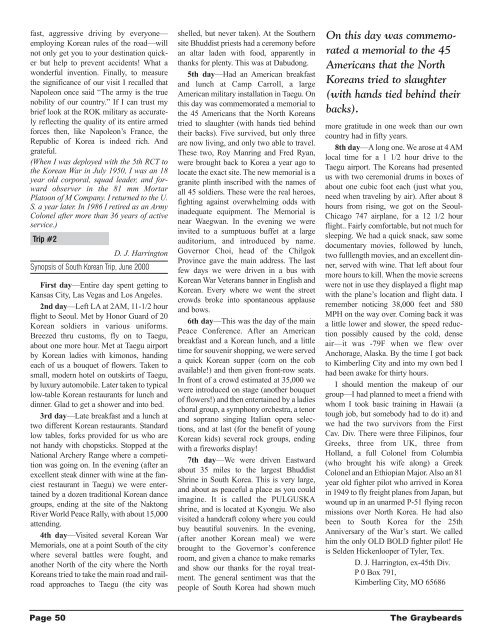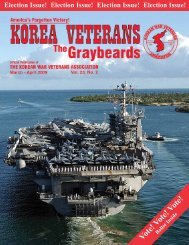The Graybeards - KWVA - Korean War Veterans Association
The Graybeards - KWVA - Korean War Veterans Association
The Graybeards - KWVA - Korean War Veterans Association
You also want an ePaper? Increase the reach of your titles
YUMPU automatically turns print PDFs into web optimized ePapers that Google loves.
fast, aggressive driving by everyone—<br />
employing <strong>Korean</strong> rules of the road—will<br />
not only get you to your destination quicker<br />
but help to prevent accidents! What a<br />
wonderful invention. Finally, to measure<br />
the significance of our visit I recalled that<br />
Napoleon once said “<strong>The</strong> army is the true<br />
nobility of our country.” If I can trust my<br />
brief look at the ROK military as accurately<br />
reflecting the quality of its entire armed<br />
forces then, like Napoleon’s France, the<br />
Republic of Korea is indeed rich. And<br />
grateful.<br />
(When I was deployed with the 5th RCT to<br />
the <strong>Korean</strong> <strong>War</strong> in July 1950, I was an 18<br />
year old corporal, squad leader, and forward<br />
observer in the 81 mm Mortar<br />
Platoon of M Company. I returned to the U.<br />
S. a year later. In 1986 I retired as an Army<br />
Colonel after more than 36 years of active<br />
service.)<br />
Trip #2<br />
D. J. Harrington<br />
Synopsis of South <strong>Korean</strong> Trip, June 2000<br />
First day—Entire day spent getting to<br />
Kansas City, Las Vegas and Los Angeles.<br />
2nd day—Left LA at 2AM, 11-1/2 hour<br />
flight to Seoul. Met by Honor Guard of 20<br />
<strong>Korean</strong> soldiers in various uniforms.<br />
Breezed thru customs, fly on to Taegu,<br />
about one more hour. Met at Taegu airport<br />
by <strong>Korean</strong> ladies with kimonos, handing<br />
each of us a bouquet of flowers. Taken to<br />
small, modern hotel on outskirts of Taegu,<br />
by luxury automobile. Later taken to typical<br />
low-table <strong>Korean</strong> restaurants for lunch and<br />
dinner. Glad to get a shower and into bed.<br />
3rd day—Late breakfast and a lunch at<br />
two different <strong>Korean</strong> restaurants. Standard<br />
low tables, forks provided for us who are<br />
not handy with chopsticks. Stopped at the<br />
National Archery Range where a competition<br />
was going on. In the evening (after an<br />
excellent steak dinner with wine at the fanciest<br />
restaurant in Taegu) we were entertained<br />
by a dozen traditional <strong>Korean</strong> dance<br />
groups, ending at the site of the Naktong<br />
River World Peace Rally, with about 15,000<br />
attending.<br />
4th day—Visited several <strong>Korean</strong> <strong>War</strong><br />
Memorials, one at a point South of the city<br />
where several battles were fought, and<br />
another North of the city where the North<br />
<strong>Korean</strong>s tried to take the main road and railroad<br />
approaches to Taegu (the city was<br />
shelled, but never taken). At the Southern<br />
site Bhuddist priests had a ceremony before<br />
an altar laden with food, apparently in<br />
thanks for plenty. This was at Dabudong.<br />
5th day—Had an American breakfast<br />
and lunch at Camp Carroll, a large<br />
American military installation in Taegu. On<br />
this day was commemorated a memorial to<br />
the 45 Americans that the North <strong>Korean</strong>s<br />
tried to slaughter (with hands tied behind<br />
their backs). Five survived, but only three<br />
are now living, and only two able to travel.<br />
<strong>The</strong>se two, Roy Manring and Fred Ryan,<br />
were brought back to Korea a year ago to<br />
locate the exact site. <strong>The</strong> new memorial is a<br />
granite plinth inscribed with the names of<br />
all 45 soldiers. <strong>The</strong>se were the real heroes,<br />
fighting against overwhelming odds with<br />
inadequate equipment. <strong>The</strong> Memorial is<br />
near Waegwan. In the evening we were<br />
invited to a sumptuous buffet at a large<br />
auditorium, and introduced by name.<br />
Governor Choi, head of the Chilgok<br />
Province gave the main address. <strong>The</strong> last<br />
few days we were driven in a bus with<br />
<strong>Korean</strong> <strong>War</strong> <strong>Veterans</strong> banner in English and<br />
<strong>Korean</strong>. Every where we went the street<br />
crowds broke into spontaneous applause<br />
and bows.<br />
6th day—This was the day of the main<br />
Peace Conference. After an American<br />
breakfast and a <strong>Korean</strong> lunch, and a little<br />
time for souvenir shopping, we were served<br />
a quick <strong>Korean</strong> supper (corn on the cob<br />
available!) and then given front-row seats.<br />
In front of a crowd estimated at 35,000 we<br />
were introduced on stage (another bouquet<br />
of flowers!) and then entertained by a ladies<br />
choral group, a symphony orchestra, a tenor<br />
and soprano singing Italian opera selections,<br />
and at last (for the benefit of young<br />
<strong>Korean</strong> kids) several rock groups, ending<br />
with a fireworks display!<br />
7th day—We were driven Eastward<br />
about 35 miles to the largest Bhuddist<br />
Shrine in South Korea. This is very large,<br />
and about as peaceful a place as you could<br />
imagine. It is called the PULGUSKA<br />
shrine, and is located at Kyongju. We also<br />
visited a handcraft colony where you could<br />
buy beautiful souvenirs. In the evening,<br />
(after another <strong>Korean</strong> meal) we were<br />
brought to the Governor’s conference<br />
room, and given a chance to make remarks<br />
and show our thanks for the royal treatment.<br />
<strong>The</strong> general sentiment was that the<br />
people of South Korea had shown much<br />
On this day was commemorated<br />
a memorial to the 45<br />
Americans that the North<br />
<strong>Korean</strong>s tried to slaughter<br />
(with hands tied behind their<br />
backs).<br />
more gratitude in one week than our own<br />
country had in fifty years.<br />
8th day—A long one. We arose at 4 AM<br />
local time for a 1 1/2 hour drive to the<br />
Taegu airport. <strong>The</strong> <strong>Korean</strong>s had presented<br />
us with two ceremonial drums in boxes of<br />
about one cubic foot each (just what you,<br />
need when traveling by air). After about 8<br />
hours from rising, we got on the Seoul-<br />
Chicago 747 airplane, for a 12 1/2 hour<br />
flight.. Fairly comfortable, but not much for<br />
sleeping. We had a quick snack, saw some<br />
documentary movies, followed by lunch,<br />
two fulllength movies, and an excellent dinner,<br />
served with wine. That left about four<br />
more hours to kill. When the movie screens<br />
were not in use they displayed a flight map<br />
with the plane’s location and flight data. I<br />
remember noticing 38,000 feet and 580<br />
MPH on the way over. Coming back it was<br />
a little lower and slower, the speed reduction<br />
possibly caused by the cold, dense<br />
air—it was -79F when we flew over<br />
Anchorage, Alaska. By the time I got back<br />
to Kimberling City and into my own bed I<br />
had been awake for thirty hours.<br />
I should mention the makeup of our<br />
group—I had planned to meet a friend with<br />
whom I took basic training in Hawaii (a<br />
tough job, but somebody had to do it) and<br />
we had the two survivors from the First<br />
Cav. Div. <strong>The</strong>re were three Filipinos, four<br />
Greeks, three from UK, three from<br />
Holland, a full Colonel from Columbia<br />
(who brought his wife along) a Greek<br />
Colonel and an Ethiopian Major. Also an 81<br />
year old fighter pilot who arrived in Korea<br />
in 1949 to fly freight planes from Japan, but<br />
wound up in an unarmed P-51 flying recon<br />
missions over North Korea. He had also<br />
been to South Korea for the 25th<br />
Anniversary of the <strong>War</strong>’s start. We called<br />
him the only OLD BOLD fighter pilot! He<br />
is Selden Hickenlooper of Tyler, Tex.<br />
D. J. Harrington, ex-45th Div.<br />
P 0 Box 791,<br />
Kimberling City, MO 65686<br />
Page 50<br />
<strong>The</strong> <strong>Graybeards</strong>

















